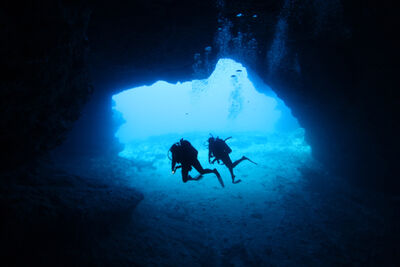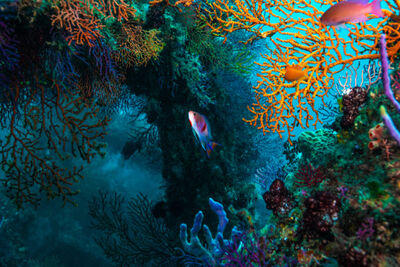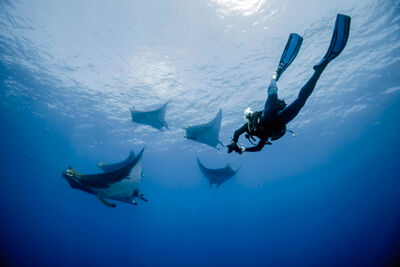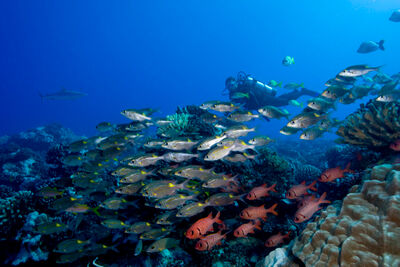We seem to be living in a world where misinformation is lurking around every corner. With the internet teeming with these 'alternative facts,' we're going to give you a few bona fide facts about scuba diving and perhaps dispel a myth or two along the way. From the deepest dive ever to what's inside a scuba tank, and from scuba diving's calorie-burning potential to why colours fade with depth, we're going to uncover some interesting scuba diving facts and perhaps pique your interest in learning to dive on your next action-packed holiday…

1. SCUBA is an acronym
While 'scuba' is generally seen and used as a proper word these days, it began life as an acronym. Jacques-Yves Cousteau and Émile Gagnan designed the first reliable and commercially successful scuba diving equipment in the early 1940s. Within 10 years, 'S.C.U.B.A.' had entered the public consciousness and started its journey to becoming an accepted word. Originally it was written as an acronym, with full stops after each letter, but nowadays it's more common to see it stylised as 'scuba.' The letters stand for Self-Contained Underwater Breathing Apparatus.
2. Scuba tanks are not filled with oxygen
One common misconception about scuba diving is that tanks are filled with oxygen. This 'alternative fact' is often repeated in mass media, but it's not quite true. While there is some oxygen in a scuba tank, it's not pure oxygen. Scuba tanks are filled with plain old air most of the time; exactly the same as what we breathe on land.
While oxygen is essential for sustaining life, the idiom 'too much of a good thing is a bad thing' rings true. When we dive, the weight of the water above us puts extra pressure on our bodies and on the gas we breathe. This extra pressure squashes the gases and makes them more 'rich'. At ten metres depth, the surrounding pressure is twice what it is at the surface. This makes the air we breathe twice as dense, and, as our lungs are still the same size as at the surface, we need to breathe in twice as much air to fill them. Each breath at ten metres depth contains twice as many oxygen particles as a breath on the surface.
But fear not; while oxygen does become toxic if we breathe in too much of it, you would need to dive deeper than 50 metres for this to be an issue with a tank full of air. And 50 metres is waaay past the recreational limits of scuba diving, so no need to worry.

3. The deepest scuba dive ever was to 332 metres
While scuba diving is generally not about pushing depth limits, certainly not for recreational divers at least, there will always be pioneers testing the limits. Technical diving involves diving beyond the limits of recreational scuba divers and is much more equipment and theory heavy. Currently, the world record for the deepest dive ever stands at 332 metres!
This record was set in 2014 by Egyptian diver Ahmed Gabr in the Red Sea. There are only a handful of divers who have passed the 300-metre mark, mainly because these types of ultra-deep dives require insane amounts of training, experience, discipline, fitness and surface support - not to mention the number of tanks needed (which are filled with special blends of gases to avoid oxygen toxicity). On the record-setting dive, Ahmed's descent took 15 minutes, but the ascent lasted a staggering 13 hours and 35 minutes!
4. Colour disappears as you dive deeper
Water is much more dense than air, so sunlight doesn't penetrate it as easily. While most recreational scuba dives stay shallower than 30 metres, even at this depth, things are less colourful than they are just below the surface. This means there wouldn't have been much for Ahmed Gabr to see at 300+ metres deep...
As sunlight struggles to penetrate the water, there is less marine life the deeper you go. But the lower levels of light also make colours seem less vibrant. Reds start to disappear first, which is why, even in the shallows, you can see underwater photographers with red filters on their cameras. Many divers also carry a small torch during the day to help put more light onto the corals, revealing their more vivid colours. The Coral Triangle is perhaps the most colourful area for scuba diving, and even though the reefs of Indonesia, Papua New Guinea and the Philippines are blessed with clear water and tropical sunshine, you can still notice the colours fading as you get closer to 30 metres deep.

5. Scuba diving is very safe
While spending time underwater can never be completely risk-free, scuba diving is very safe when you follow your training and the rules of diving. You may hear stories about 'the bends' and 'nitrogen narcosis' being dangerous, but the truth is the most common scuba diving injury is a bruised or broken big toe (usually due to not handling the weight belt as taught when you learn to dive).
'The bends' is a more colloquial term for decompression sickness. This is easy to avoid by staying within your depth and time limits and by ascending slowly. Nitrogen narcosis is the effect of nitrogen under pressure. The exact nature of this is still a mystery to scientists, but it only becomes an issue on deeper dives. Nitrogen narcosis involves diminished thinking and slower reactions - a similar feeling to being slightly tipsy.
The other major issue, which is also very easy to avoid, is lung injuries. To avoid any lung problems, you just have to bear in mind the most important rule in scuba diving: never hold your breath.
6. Scuba diving burns lots of calories
Perhaps one of the lesser-known scuba diving facts is that you actually burn a lot of calories during a dive. Experts suggest you can burn around 600 calories per hour while enjoying a relaxing dive, depending on a few factors.
Much of this is due to the fact that the water is cooler than your body temperature and, due to its density, it can carry body heat away from you more readily than air does. All the time you are underwater, your body needs to work to maintain your temperature. This effort burns calories. On dives when there is a current and you have to swim against it, you will burn even more calories too.

7. The best dive destination in the world is up to you...
A common discussion among divers is 'Where is the best place to dive?'. While places like the Galapagos, Papua New Guinea and Palau often get mentioned during these conversations, the truth is that it is subjective, and the choice of the world's best dive destination will differ from person to person. Some people love to dive on wrecks, while others prefer coral reefs or even cave diving. Some divers want to see lots of sharks, some prefer graceful manta rays, while others prefer hunting for weird and wonderful muck diving critters.
Wreck divers tend to love Chuuk Lagoon, shark lovers often head to the Galapagos or Palau, and coral and critter lovers will enjoy the colourful conditions of Indonesia, the Philippines and Papua New Guinea. But all in all, divers just love to dive. From the gin-clear visibility of Iceland down to the seamounts of the Azores and throughout the tropics - from the Caribbean all the way eastwards to the Galapagos - your favourite dive destination is out there somewhere waiting for you to find it...
















